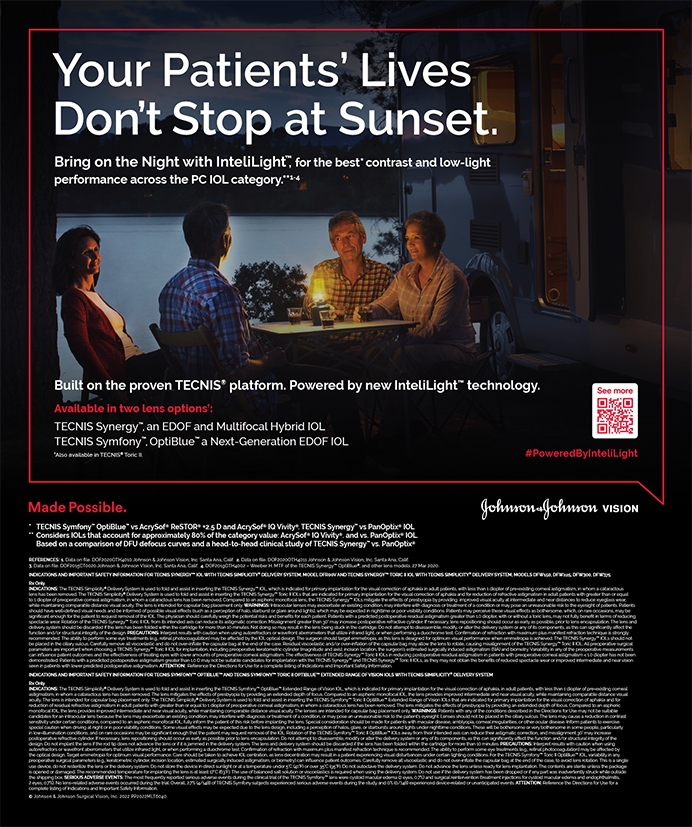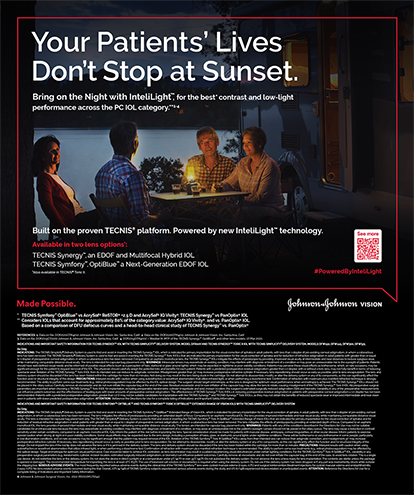Refractive Surgery | Sep 2005
A 5-Minute, $15 Cure for Blindness
Tackling cataract blindness in the developing world.
David F. Chang, MD
Despite what modern technology has done to advance the treatment of cataracts, the greatest challenge in our field continues to be the large and increasing backlog of cataract blindness in developing countries.1-5 In North America and Europe, research focus has shifted toward exciting new IOL technology to reverse lens aging (presbyopia). Meanwhile, millions of people in developing nations with reversible blindness due to cataracts go untreated.
Reducing this backlog of cataract blindness is a formidable challenge. Phacoemulsification machines are expensive to purchase and maintain, and they add relatively high disposable costs on top of the expense of the IOL. Foldable IOLs are cost-prohibitive for poor populations. The extensive surgical training required for phacoemulsification is unrealistic where there are severe shortages of ophthalmologists. Finally, the brunescent and mature cataracts typical of underserved populations make phacoemulsification significantly more difficult and prone to complication. What is needed is a high-volume, cost-effective, low-technology procedure to treat the most advanced cataracts with a low complication rate in the shortest amount of time.
This goal is being achieved in a handful of international programs that are providing a hopeful paradigm for overcoming worldwide cataract blindness. I have had the privilege of visiting both the Aravind Eye Hospital network in Southern India and the Tilganga Eye Center in Kathmandu, Nepal. Seeing firsthand how their systems provide high-volume, low-cost cataract surgery is an awe-inspiring experience for any visiting ophthalmologist.
ARAVIND EYE HOSPITAL
Founded in 1976 by G. Venkataswamy, MD, Aravind Eye Hospital in southern India has grown into a network of five regional eye hospitals that provide high-level ophthalmic care to the poor population of southern India. Private, paying patients comprise approximately 30% of the network's patient base, and this revenue funds 70% of its services, which are provided at no cost to the indigent via a financially self-sustaining program that receives minimal government reimbursement. In terms of cataract surgery, this funding means that, of the approximately 200,000 procedures performed annually in the Aravind system, 70% are provided for free. The Harvard Business School highlighted this remarkably efficient system as a case study.
Although private cataract patients at Aravind may pay anywhere from $200 to $300 to undergo phacoemulsification and implantation of US-imported foldable IOLs, the nonpaying cataract patients are treated for less than $15 per case (including the IOL). This low-cost surgery is accomplished by performing a manual, sutureless, small-incision extracapsular procedure with reusable equipment and supplies.6-9 Aurolab (Madurai, India), the IOL manufacturing division of Aravind Eye, produces PMMA IOLs for less than $5 each. Following retrobulbar anesthesia, the nucleus is expressed through a capsulorhexis and a temporal, self-sealing 6.0- to 6.5-mm scleral pocket incision. Manual cortical cleanup precedes capsular bag implantation of a PMMA IOL. The technique is commonly abbreviated as manual SICS (small incision cataract surgery).
Although the procedure itself seems straightforward, it is the stunning speed, skill, and efficiency with which it is performed that visiting surgeons must see to believe. By alternating between two parallel OR tables, a single surgeon is able to perform more than 15 cases per hour by consistently completing sub–5-minute procedures on the densest of cataracts with no intervening turnover time (Figure 1). To ensure efficiency across different surgical teams, every aspect of the procedure is standardized, from preoperative patient and instrument preparation to the surgical steps themselves. While the surgeon is operating on one eye, a separate OR team prepares and drapes the next patient. The surgeon merely has to rinse his or her gloves with antiseptic before moving the operating microscope to the next patient.
Having been screened in outlying eye camps, as many as 300 to 400 cataract patients will be bused to an Aravind eye hospital, where they will all undergo surgery in one single day. After several days of in-house follow-up, they are transported back to their rural villages, where a local postoperative visit and refraction are performed 1 month later by the Aravind staff. This standardized Aravind system streamlines and centralizes cataract care by performing all surgeries in the main hospital.10
THE TILgaNGA EYE CENTER
Founded in 1994 by Sanduk Ruit, MD, the Tilganga Eye Center (Kathmandu, Nepal) is a shining example of an efficient eye care delivery system on a smaller scale. Dr. Ruit has developed his own variation of the manual, sutureless SICS.11-13 Tilganga Eye Center is also financially self-sustaining, wherein private care subsidizes charity care. It also has its own IOL manufacturing facility, which, like that at Aravind, is able to supply low-cost IOLs to other developing countries. Because the rural population in Nepal is so widely scattered amongst mountain villages that are accessible only by foot, the Tilganga system strives to deliver portable cataract care by transporting the necessary staff and equipment to remote eye camps (Figure 2).14,15 Using a single portable operating table, the Tilganga surgeons can perform more than 10 cataract surgeries per hour (Figure 3). As at Aravind, the high-volume, cost-effective Tilganga surgical techniques and protocols are standardized across their surgical teams.
Although each system operates on a different scale and serves different types of communities, Aravind and Tilganga are complimentary models of how best to address the world's backlog of cataract blindness. They demonstrate that the solution requires not just a cost-effective surgical technique, but also an entire system of efficient and financially self-sustaining cataract care delivery. There must be a system for attracting, screening, diagnosing, and transporting cataract patients to and from rural camps. There must be a source of low-cost IOLs, medications, and supplies. Most importantly, there must be highly coordinated teams of dedicated ophthalmologists and support staff who execute their roles with military precision. To ensure maximum efficiency and reproducibility, there must be a standard protocol for every aspect of care.
From the standpoint of cost effectiveness, studies have shown that manual SICS is clearly superior to the alternatives,16,17 but how good are the results? Last month, the Aravind team published a detailed outcome study of their high-volume, manual SICS system.18 Two days' surgical volume for three cataract surgeons (approximately 600 cases) were randomly selected and reviewed retrospectively. Despite a high percentage of advanced and mature cataracts, operative complications were extremely low, and vitreous loss occurred in less than 1% of cases. With 6-week follow-up of nearly 90% of the patients,
95% achieved a BCVA of at least 6/18 (not excluding macular or other pathology). These outcomes are more impressive considering that almost 90% of the patients had preoperative vision of 5/60 or worse, and that the surgical time for these nearly 600 patients averaged 3.75 minutes.
Outcome studies such as these provide convincing evidence that surgical systems, such as those at Aravind and Tilganga, are the most promising, efficacious, and cost-effective means to eradicate cataract blindness in developing countries. Beyond the impressive productivity of these two institutions, equally important has been their desire and ability to train surgical teams from other developing countries in their methods of cataract surgery. An efficient, high-volume system utilizing low-cost, sub–5-minute procedures to tackle advanced cataracts with minimal complications is clearly the best way to leverage the scarcest and most precious asset of the system—the cataract surgeon.
David F. Chang, MD, is Clinical Professor at the University of California, San Francisco, and is in private practice in Los Altos, California. Dr. Chang may be reached at (650) 948-9123; dceye@earthlink.net.
1. WHO Fact Sheet No 213. Global Initiative for the Elimination of Avoidable Blindness. Geneva, Switzerland: WHO; February 2000.
2. Dandona R, Dandona L. Socioeconomic status and blindness. Br J Ophthalmol. 2001;85:1484-1488.
3. Arnold J. Global cataract blindness: the unmet challenge [editorial]. Br J Ophthalmol. 1998;82:593-594.
4. Thylefors B. A global initiative for the elimination of avoidable blindness [editorial]. Am J Ophthalmol. 1998;125:90-93.
5. Minassian DC, Mehra V. 3.8 million blinded by cataract each year: projections from the first epidemiological study of incidence of cataract blindness in India. Br J Ophthalmol. 1990;74:341-343.
6. Civerchia L, Ravindran RD, Apoorvananda SW, et al. High volume intraocular lens surgery in a rural eye camp in India. Ophthalmic Surg Lasers. 1996;27:200-208.
7. Prajna NV, Chandrakanth KS, Kim R, et al. The Madurai intraocular lens study II: clinical outcomes. Am J Ophthalmol. 1998;125:14-25.
8. Natchiar G, DabralKar T. Manual small incision suture less cataract surgery–an alternative technique to instrumental phacoemulsification. Operative Techniques Cataract Refract Surg. 2000;3:161-170.
9. Balent LC, Narendran K, Patel S, et al. High volume sutureless intraocular lens surgery in a rural eye camp in India. Ophthalmic Surg Lasers. 2001;32:446-455.
10. Natchiar G, Robin AL, Thulasiraj R, et al. Attacking the backlog of India's curable blind; the Aravind Eye Hospital model. Arch Ophthalmol. 1994;112:987-993.
11. Ruit S, Tabin GC, Nissman SA, et al. Low-cost high-volume extracapsular cataract extraction with posterior chamber intraocular lens implantation in Nepal. Ophthalmology. 1999;106:1887-1892.
12. Ruit S, Paudyal G, Gurung R, et al. An innovation in developing world cataract surgery: sutureless extracapsular cataract extraction with intraocular lens implantation. Clin Experiment Ophthalmol. 2000;28:274-279.
13. Hennig A, Kumar J, Yorston D, Foster A. Sutureless cataract surgery with nucleus extraction: outcome of a prospective study in Nepal. Br J Ophthalmol. 2003;87:266-270.
14. Pokharel GP, Regmi G, Shrestha SK, et al. Prevalence of blindness and cataract surgery in Nepal. Br J Ophthalmol. 1998;82:600-605.
15. Pokharel GP, Selvaraj S, Ellwein LB. Visual functioning and quality of life outcomes among cataract operated and unoperated blind populations in Nepal. Br J Ophthalmol. 1998;82:606-610.
16. Gogate PM, Deshpande M, Wormald RP. Is manual small incision cataract surgery affordable in developing countries? A cost comparison with extracapsular cataract extraction. Br J Ophthalmol. 2003;87:843-846.
17. Muralikrishnan R, Venkatesh R, Prajna NV, Frick KD. Economic cost of cataract surgery procedures in an established eye care centre in Southern India. Ophthalmic Epidemiol. 2004;11:369-380.
18. Venkatesh R, Muralikrishnan R, Linda C, et al. Outcomes of high volume cataract surgeries in a developing country. Br J Ophthalmol. 2005;89:1079-1083.


